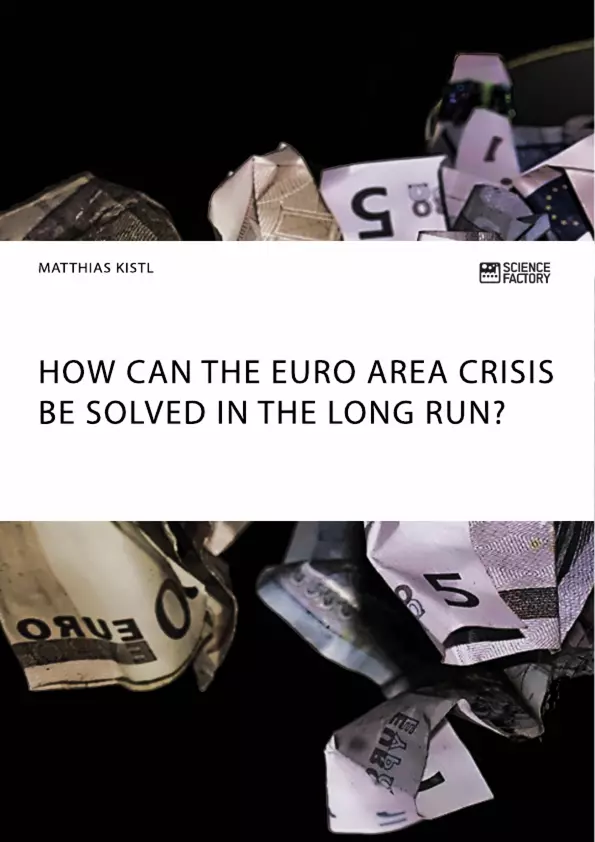The preservation of the Monetary Union for Europe is linked to the future of a whole continent. The currency crisis impacts everybody. It is unequivocal that major efforts were necessary to prevent the break-up of the euro area. However, some of the countermeasures led to disagreements and fierce criticism. A long-term solution must be found. Many proposals haven been contributed in order to do so but are they both expedient and agreeable?
This publication approaches this question by beginning with a brief theoretical introduction about the fundamental advantages and disadvantages of the Monetary Union. Based on this, the history of the crisis of the euro system is described. It becomes clear that a key problem in finding a solution is the disagreement about the causes of the currency crisis. Further chapters summarize which rescue measures were used and analyze how they are already solving the weaknesses of the euro. Here, the reader will see that there is a long way before the Monetary Union stands on a stable framework. In this book, suggested solutions are discussed and analyzed, before finally a combination of different solutions is emphasized.
In this book:
- Monetary Union,
- Currency Crisis,
- Euro Reforms,
- History of the euro.
Inhaltsverzeichnis (Table of Contents)
- Introduction
- Origins of the euro area crisis
- Theory: Optimum currency areas
- Design flaws in the EMU
- Rescue operations and structural reforms: what was done to prevent the break-up of the eurozone?
- Macroeconomic (rescue) measures
- Monetary Policy
- Banking Union
- Assessment and problems still to be solved
- Macroeconomic measures
- Monetary Policy
- Banking Union
- Competitiveness levels
- Further obstacles and problems
- Interim Conclusion
- Proposals
- Proposals including more integration in the eurozone
- Proposals including more individual responsibility and/or less integration in the eurozone
- Assessment
- Conclusion
Zielsetzung und Themenschwerpunkte (Objectives and Key Themes)
This book examines the Eurozone crisis from its origins to its current state, analyzing the causes, rescue measures, and ongoing challenges. It aims to provide a comprehensive understanding of the crisis, its potential solutions, and the long-term implications for the euro area.
- Origins and causes of the Eurozone crisis
- Rescue measures and structural reforms
- Assessment of the effectiveness of past interventions
- Analysis of remaining challenges and potential solutions
- Discussion of long-term implications for the Eurozone
Zusammenfassung der Kapitel (Chapter Summaries)
- Chapter 1: Introduction: This chapter sets the stage for the book, outlining the euro area crisis and its significance. It introduces key concepts and provides an overview of the topics to be covered in subsequent chapters.
- Chapter 2: Origins of the euro area crisis: This chapter delves into the theoretical foundations of optimal currency areas and analyzes the structural flaws in the design of the European Monetary Union (EMU) that contributed to the crisis.
- Chapter 3: Rescue operations and structural reforms: what was done to prevent the break-up of the eurozone?: This chapter explores the various macroeconomic measures, monetary policy interventions, and banking union initiatives undertaken to address the crisis and prevent the collapse of the Eurozone.
- Chapter 4: Assessment and problems still to be solved: This chapter evaluates the effectiveness of the rescue measures and structural reforms implemented, highlighting remaining challenges and issues that need to be addressed. It examines macroeconomic imbalances, monetary policy limitations, and banking union shortcomings.
- Chapter 5: Proposals: This chapter presents a range of proposals for addressing the Eurozone crisis, including options for greater integration within the euro area and strategies for enhancing individual responsibility and reducing integration.
- Chapter 6: Assessment: This chapter provides a comprehensive assessment of the proposed solutions, analyzing their potential benefits and drawbacks, and weighing their feasibility and effectiveness.
Schlüsselwörter (Keywords)
The core themes of this work encompass the Eurozone crisis, its causes, rescue measures, ongoing challenges, and potential solutions. Key topics include: optimal currency areas, EMU design flaws, macroeconomic imbalances, monetary policy interventions, banking union, competitiveness, and integration strategies.
- Quote paper
- Matthias Kistl (Author), 2017, How can the euro area crisis be solved in the long run?, Munich, GRIN Verlag, https://www.grin.com/document/379131



